跨国公司成功的案例——联合利华
- 格式:ppt
- 大小:1.70 MB
- 文档页数:21
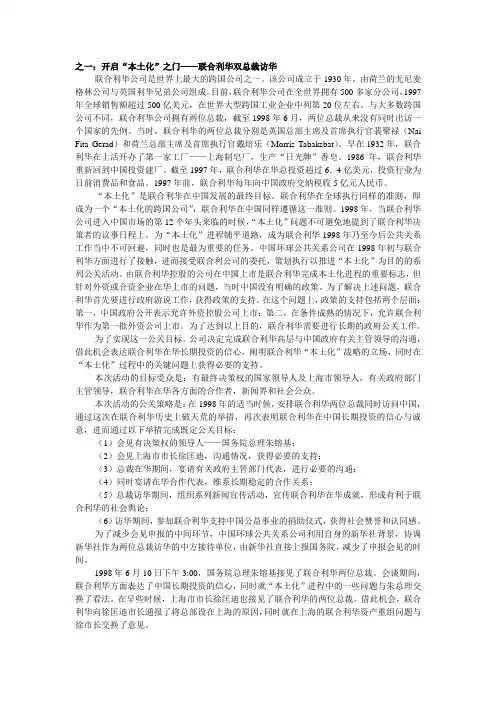
之一:开启“本土化”之门——联合利华双总裁访华联合利华公司是世界上最大的跨国公司之一。
该公司成立于1930年,由荷兰的尤尼麦格林公司与英国利华兄弟公司组成。
目前,联合利华公司在全世界拥有500多家分公司,1997年全球销售额超过500亿美元,在世界大型跨国工业企业中列第20位左右。
与大多数跨国公司不同,联合利华公司拥有两位总裁,截至1998年6月,两位总裁从来没有同时出访一个国家的先例。
当时,联合利华的两位总裁分别是英国总部主席及首席执行官裴聚禄(Nai Fita Gerad)和荷兰总部主席及首席执行官戴培乐(Morris Tabaksbat)。
早在1932年,联合利华在上活开办了第一家工厂——上海制皂厂,生产“日光牌”香皂。
1986年,联合利华重新回到中国投资建厂。
截至1997年,联合利华在华总投资超过6.4亿美元,投资行业为日前消费品和食品。
1997年前,联合利华每年向中国政府交纳税收5亿元人民币。
“本土化”是联合利华在中国发展的最终目标。
联合利华在全球执行同样的准则,即成为一个“本土化的跨国公司”,联合利华在中国同样遵循这一准则。
1998年,当联合利华公司进入中国市场的第12个年头来临的时候,“本土化”问题不可避免地提到了联合利华决策者的议事日程上。
为“本土化”进程铺平道路,成为联合利华1998年乃至今后公共关系工作当中不可回避,同时也是最为重要的任务。
中国环球公共关系公司在1998年初与联合利华方面进行了接触,进而接受联合利公司的委托,策划执行以推进“本土化”为目的的系列公关活动。
由联合利华控股的公司在中国上市是联合利华完成本土化进程的重要标志,但针对外资或合资企业在华上市的问题,当时中国没有明确的政策。
为了解决上述问题,联合利华首先要进行政府游说工作,获得政策的支持。
在这个问题上,政策的支持包括两个层面:第一,中国政府公开表示允许外资控股公司上市;第二,在条件成熟的情况下,允许联合利华作为第一批外资公司上市。
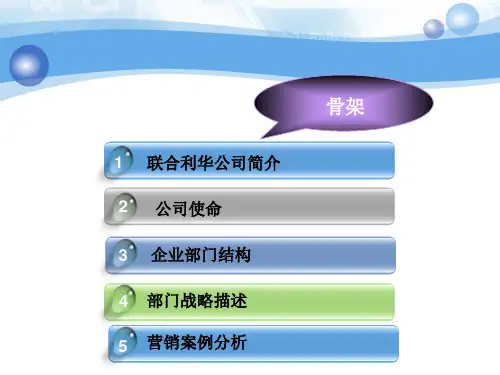


联合利华一、公司简介早在二十世纪三十年代,联合利华的前身利华兄弟公司在上海投资开设的中国肥皂有限公司生产的“力士”香皂、“伞”牌肥皂等产品因品质优良成为中国市场的畅销货。
1986年联合利华重返上海,第一家合资企业上海利华有限公司继续生产“力士”香皂。
限于当时的生活水平,使用“力士”香皂被年轻人视作“开放”、“时尚”的象征。
至今“力士”是中国销量第一的香皂。
上海利华有限公司自1987年12月正式投产以来,企业规模不断扩大,产品品种年年增加,经济效益日益提高。
产品品种从初期单一的力士香皂2种规格发展到1996年的四大类72种规格。
地址为上海市杨树浦路2310号。
公司现已发展成为全国著名的日化产品企业,连续六年被评为外商投资先进技术企业,并荣获94年度全国外商投资双优企业称号。
1995至1996年度被列入全国500家最大外商投资工业企业行列。
自一九八六年至一九九九年,联合利华在中国已投资八亿美元,建立了十四家合资企业,引进一百多项先进的专利技术。
旁氏、力士、夏士莲、奥妙、中华、立顿黄牌、和路雪等十三个品牌分属家庭及个人护理用品、冰淇淋、食品等三个系列的产品,使得在中国贴有联合利华标签的产品种类已经可供开设一家很象样的商店,并且联系着人们日常生活的各个方面。
目前,联合利华在全球有400多个品牌,其中大部分是收购来并推广到世界各地,比如,旁氏原是一个美国品牌,联合利华将其买下并发展为一个护肤品名牌,推广到中国;而“夏士莲”原是在东南亚推广的一个英国牌子,联合利华也将其引入中国。
“成为本地化的跨国公司”是联合利华的全球经营宗旨和长期以来的传统。
这些年来,联合利华不仅将众多国际品牌带进中国市场;同时大力培植中国本地的品牌。
在上海收购了一个食品类名牌“老蔡酱油”之后,1999年又有两次引人注目的收购行动:一是收购北京食品名牌“京华茶叶”,二是利用旗下占有世界15%市场份额的冰激凌品牌“和路雪”收购另一上海冰激凌名牌“蔓登琳”。
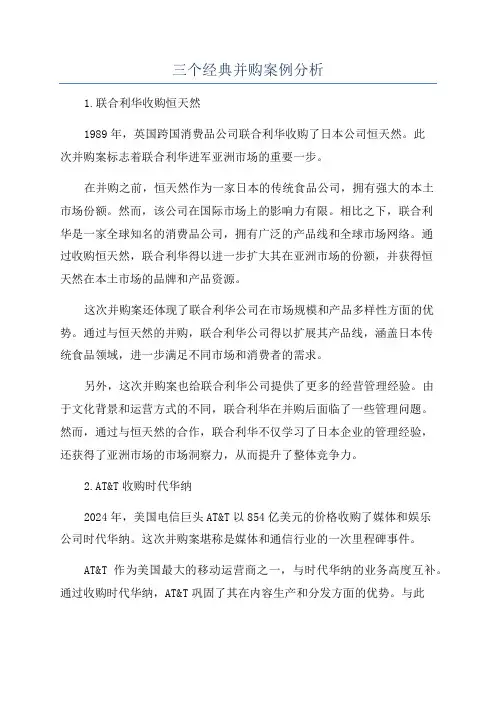
三个经典并购案例分析1.联合利华收购恒天然1989年,英国跨国消费品公司联合利华收购了日本公司恒天然。
此次并购案标志着联合利华进军亚洲市场的重要一步。
在并购之前,恒天然作为一家日本的传统食品公司,拥有强大的本土市场份额。
然而,该公司在国际市场上的影响力有限。
相比之下,联合利华是一家全球知名的消费品公司,拥有广泛的产品线和全球市场网络。
通过收购恒天然,联合利华得以进一步扩大其在亚洲市场的份额,并获得恒天然在本土市场的品牌和产品资源。
这次并购案还体现了联合利华公司在市场规模和产品多样性方面的优势。
通过与恒天然的并购,联合利华公司得以扩展其产品线,涵盖日本传统食品领域,进一步满足不同市场和消费者的需求。
另外,这次并购案也给联合利华公司提供了更多的经营管理经验。
由于文化背景和运营方式的不同,联合利华在并购后面临了一些管理问题。
然而,通过与恒天然的合作,联合利华不仅学习了日本企业的管理经验,还获得了亚洲市场的市场洞察力,从而提升了整体竞争力。
2.AT&T收购时代华纳2024年,美国电信巨头AT&T以854亿美元的价格收购了媒体和娱乐公司时代华纳。
这次并购案堪称是媒体和通信行业的一次里程碑事件。
AT&T作为美国最大的移动运营商之一,与时代华纳的业务高度互补。
通过收购时代华纳,AT&T巩固了其在内容生产和分发方面的优势。
与此同时,时代华纳公司也能够获得更广泛的市场渠道,推动其优质内容在移动和在线领域的传播。
这次并购案还能为AT&T提供更多的增长机会。
通信和媒体行业越来越融合,通过整合时代华纳的资源和内容创作能力,AT&T能够更好地满足用户对媒体和娱乐内容的需求。
此外,通过与时代华纳的合作,AT&T 还进一步提升了其在数字广告和用户数据分析方面的能力,为公司未来的发展提供了技术支持。
然而,这次并购案也面临一些挑战。
首先,合并不同文化和运营方式的难度非常大。
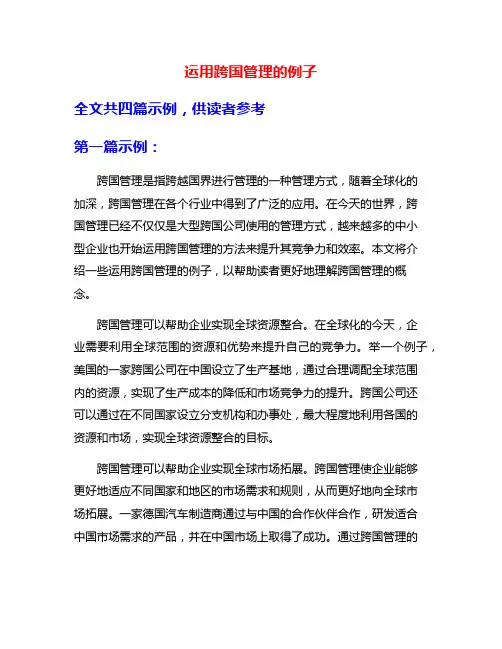
运用跨国管理的例子全文共四篇示例,供读者参考第一篇示例:跨国管理是指跨越国界进行管理的一种管理方式,随着全球化的加深,跨国管理在各个行业中得到了广泛的应用。
在今天的世界,跨国管理已经不仅仅是大型跨国公司使用的管理方式,越来越多的中小型企业也开始运用跨国管理的方法来提升其竞争力和效率。
本文将介绍一些运用跨国管理的例子,以帮助读者更好地理解跨国管理的概念。
跨国管理可以帮助企业实现全球资源整合。
在全球化的今天,企业需要利用全球范围的资源和优势来提升自己的竞争力。
举一个例子,美国的一家跨国公司在中国设立了生产基地,通过合理调配全球范围内的资源,实现了生产成本的降低和市场竞争力的提升。
跨国公司还可以通过在不同国家设立分支机构和办事处,最大程度地利用各国的资源和市场,实现全球资源整合的目标。
跨国管理可以帮助企业实现全球市场拓展。
跨国管理使企业能够更好地适应不同国家和地区的市场需求和规则,从而更好地向全球市场拓展。
一家德国汽车制造商通过与中国的合作伙伴合作,研发适合中国市场需求的产品,并在中国市场上取得了成功。
通过跨国管理的方式,企业可以更好地了解各国市场的需求和规则,灵活调整自己的战略,从而更好地向全球市场拓展。
跨国管理可以帮助企业实现跨文化团队的协同合作。
在跨国经营中,企业通常需要跨越不同文化和语言的障碍来进行合作,跨国管理可以帮助企业更好地管理跨文化团队,实现协同合作。
一家日本跨国公司在全球范围内设立了分支机构,其员工来自不同的国家和文化背景。
通过培训和交流活动,公司成功地实现了员工之间的合作和协调,提升了团队的凝聚力和效率。
通过跨国管理的方式,企业可以更好地发挥全球团队的优势,实现跨文化团队的协同合作。
跨国管理可以帮助企业实现全球化人才的培养和发展。
在跨国经营中,企业需要具有全球视野和跨文化沟通能力的人才来应对不同国家和地区的挑战。
跨国管理可以帮助企业建立完善的人才培养体系,为员工提供培训和发展机会,从而提升员工的全球视野和跨文化沟通能力。
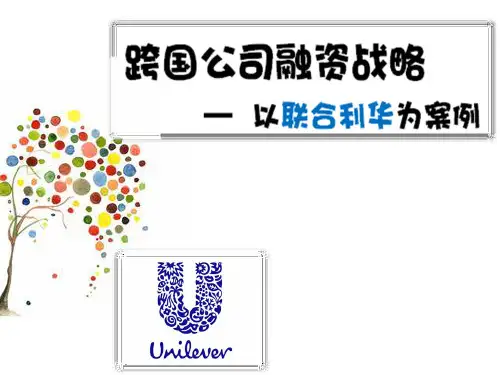
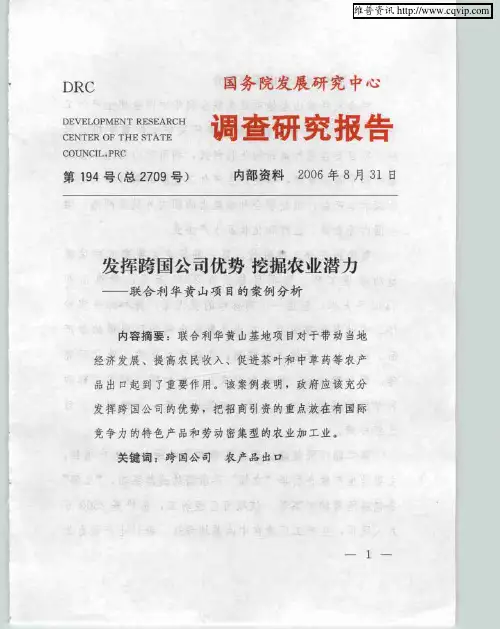
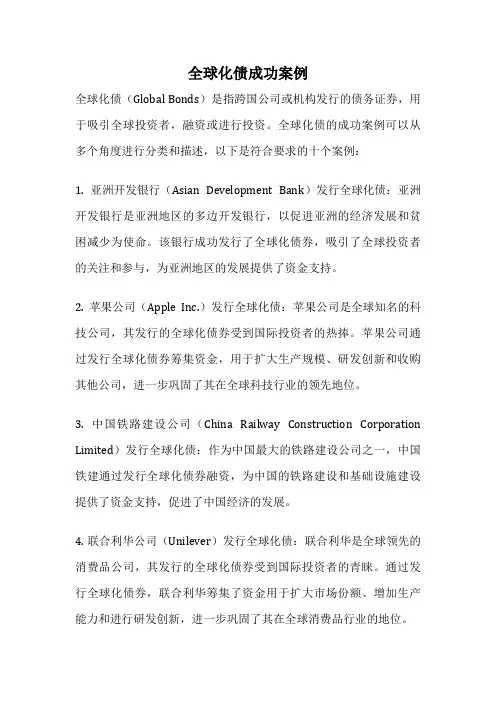
全球化债成功案例全球化债(Global Bonds)是指跨国公司或机构发行的债务证券,用于吸引全球投资者,融资或进行投资。
全球化债的成功案例可以从多个角度进行分类和描述,以下是符合要求的十个案例:1. 亚洲开发银行(Asian Development Bank)发行全球化债:亚洲开发银行是亚洲地区的多边开发银行,以促进亚洲的经济发展和贫困减少为使命。
该银行成功发行了全球化债券,吸引了全球投资者的关注和参与,为亚洲地区的发展提供了资金支持。
2. 苹果公司(Apple Inc.)发行全球化债:苹果公司是全球知名的科技公司,其发行的全球化债券受到国际投资者的热捧。
苹果公司通过发行全球化债券筹集资金,用于扩大生产规模、研发创新和收购其他公司,进一步巩固了其在全球科技行业的领先地位。
3. 中国铁路建设公司(China Railway Construction Corporation Limited)发行全球化债:作为中国最大的铁路建设公司之一,中国铁建通过发行全球化债券融资,为中国的铁路建设和基础设施建设提供了资金支持,促进了中国经济的发展。
4. 联合利华公司(Unilever)发行全球化债:联合利华是全球领先的消费品公司,其发行的全球化债券受到国际投资者的青睐。
通过发行全球化债券,联合利华筹集了资金用于扩大市场份额、增加生产能力和进行研发创新,进一步巩固了其在全球消费品行业的地位。
5. 麦当劳公司(McDonald's Corporation)发行全球化债:麦当劳是全球最大的快餐连锁企业之一,其发行的全球化债券吸引了众多国际投资者的关注。
通过发行全球化债券,麦当劳融资用于扩大门店数量、加强品牌推广和进行技术升级,进一步扩大了其在全球快餐行业的市场份额。
6. 日本政府发行全球化债:作为世界第三大经济体,日本政府通过发行全球化债券筹集资金,用于国内经济发展和公共项目建设。
日本政府发行的全球化债券备受国际投资者的认可和追捧,为日本经济的发展提供了重要支持。
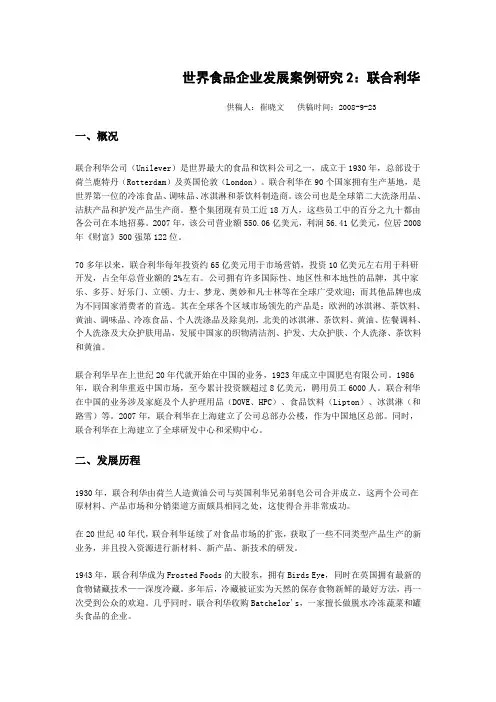
世界食品企业发展案例研究2:联合利华供稿人:崔晓文供稿时间:2008-9-23一、概况联合利华公司(Unilever)是世界最大的食品和饮料公司之一,成立于1930年,总部设于荷兰鹿特丹(Rotterdam)及英国伦敦(London)。
联合利华在90个国家拥有生产基地,是世界第一位的冷冻食品、调味品、冰淇淋和茶饮料制造商。
该公司也是全球第二大洗涤用品、洁肤产品和护发产品生产商。
整个集团现有员工近18万人,这些员工中的百分之九十都由各公司在本地招募。
2007年,该公司营业额550.06亿美元,利润56.41亿美元,位居2008年《财富》500强第122位。
70多年以来,联合利华每年投资约65亿美元用于市场营销,投资10亿美元左右用于科研开发,占全年总营业额的2%左右。
公司拥有许多国际性、地区性和本地性的品牌,其中家乐、多芬、好乐门、立顿、力士、梦龙、奥妙和凡士林等在全球广受欢迎;而其他品牌也成为不同国家消费者的首选。
其在全球各个区域市场领先的产品是:欧洲的冰淇淋、茶饮料、黄油、调味品、冷冻食品、个人洗涤品及除臭剂,北美的冰淇淋、茶饮料、黄油、佐餐调料、个人洗涤及大众护肤用品,发展中国家的织物清洁剂、护发、大众护肤、个人洗涤、茶饮料和黄油。
联合利华早在上世纪20年代就开始在中国的业务,1923年成立中国肥皂有限公司。
1986年,联合利华重返中国市场,至今累计投资额超过8亿美元,聘用员工6000人。
联合利华在中国的业务涉及家庭及个人护理用品(DOVE、HPC)、食品饮料(Lipton)、冰淇淋(和路雪)等。
2007年,联合利华在上海建立了公司总部办公楼,作为中国地区总部。
同时,联合利华在上海建立了全球研发中心和采购中心。
二、发展历程1930年,联合利华由荷兰人造黄油公司与英国利华兄弟制皂公司合并成立,这两个公司在原材料、产品市场和分销渠道方面颇具相同之处,这使得合并非常成功。
在20世纪40年代,联合利华延续了对食品市场的扩张,获取了一些不同类型产品生产的新业务,并且投入资源进行新材料、新产品、新技术的研发。
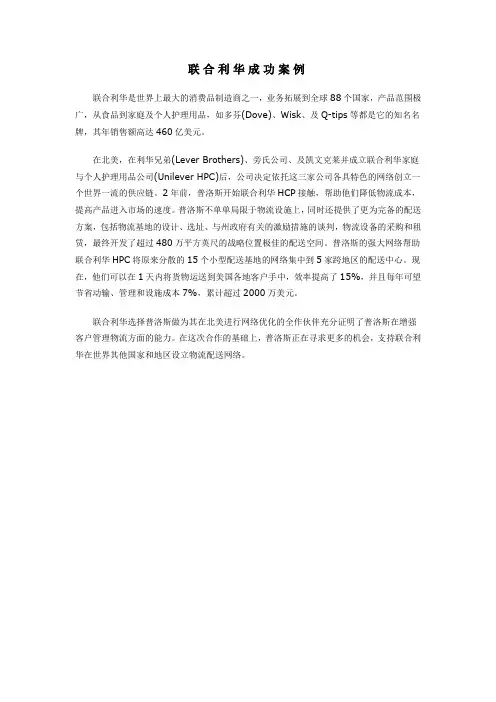
联合利华成功案例
联合利华是世界上最大的消费品制造商之一,业务拓展到全球88个国家,产品范围极广,从食品到家庭及个人护理用品,如多芬(Dove)、Wisk、及Q-tips等都是它的知名名牌,其年销售额高达460亿美元。
在北美,在利华兄弟(Lever Brothers)、旁氏公司、及凯文克莱并成立联合利华家庭与个人护理用品公司(Unilever HPC)后,公司决定依托这三家公司各具特色的网络创立一个世界一流的供应链。
2年前,普洛斯开始联合利华HCP接触,帮助他们降低物流成本,提高产品进入市场的速度。
普洛斯不单单局限于物流设施上,同时还提供了更为完备的配送方案,包括物流基地的设计、选址、与州政府有关的激励措施的谈判,物流设备的采购和租赁,最终开发了超过480万平方英尺的战略位置极佳的配送空间。
普洛斯的强大网络帮助联合利华HPC将原来分散的15个小型配送基地的网络集中到5家跨地区的配送中心。
现在,他们可以在1天内将货物运送到美国各地客户手中,效率提高了15%,并且每年可望节省动输、管理和设施成本7%,累计超过2000万美元。
联合利华选择普洛斯做为其在北美进行网络优化的全作伙伴充分证明了普洛斯在增强客户管理物流方面的能力。
在这次合作的基础上,普洛斯正在寻求更多的机会,支持联合利华在世界其他国家和地区设立物流配送网络。
剖析联合利华的成功跨国经营内容摘要:本文介绍了跨国企业联合利华的经营案例,挖掘了背后的经营策略,深度剖析了联合利华作为一个成功的跨国企业,在不断不运动的内外环境下,如何确定经营战略,执掌国际贸易的大权。
阐述了跨国企业联合利华对外投资的动机和方式以及经营的具体论述。
最后本文指出,跨国企业经营中存在的不合理或者问题,给与不完全的解决方案以及对来发展的建议。
Abstract:This paper introduces the multinational company Unilever's business case and business strategy, which are hidden in the deep. Then analyzes the Unilever, as a successful multinational enterprise,how to determine the operation strategy,at the continue movement of the internal and external environment, at last in charge of international trade. The paper clarify the way of multinational Unilever business and its motivation in foreign investment, and the specific management. At the end of the paper points out that unreasonable or that exist in the transnational enterprise management problems, gives the incomplete solutions and Suggestions to develop.关键词:联合利华;国际化经营;内外部环境;投资动机;Keyword:Unilever;International operation;Internal and external environment;The motivation of investment;一.An overview of Unilever(一)The history of UnileverUnilever is one of the world top 500 and has offices in 75 countries around the world, with over 500 subsidiaries, the total number of employees nearly 300000 people, an annual turnover of more than $40 billion. Is the world's second largest consumer products manufacturers, is one of the most profitable company in the world, is a famous multinational enterprises.According to the latest list of the world's top 500, 2015, 153 Unilever, and operating income of $64.2518 billion, the profit of $6.8592 billion, year-on-year growth of 4.8%.In the 1890 s, William Heskith Lever, one of the founders of Unilever, then put forward the "lighten the burden of housework, let users better life" concept. Unilever's global vision: every day, we are committed to create a better future.In 1929, the Lever and the Dutch Margarine Unie company signed an agreement, to form a Unilever (Unilever) company. After 80 years of development, Unilever has became one of the world's largest consumer products companies, has more than 171000 employees worldwide. In fiscal year 2011, the company annual sales about approximately 46.5 billion.Unilever in the field of cutting-edge research and development investment of nearly 891 million euros in 2009. Established in Britain, the Netherlands, the United States, India and China's six major global research and development center, is constantly explore innovative products of new technology and new ideas, provide consumers with more value of brands and products. As one of the world's largest advertisers, Unilever's annual total world spending on advertising and marketing more than 5billion euros.Unilever on six continents with 264 production base. They are constantly pursue more on safety, high efficiency, high quality and environmental protection performance, Unilever's global standards and management system.(二)The Chinese path of Unilever1923, Unilever co., LTD., the predecessor of --- Lever brothers company investment in China to offer British merchant soap co., LTD., production was formally established in China, Unilever's founder, William Heskith Lever started to soap trade in China, Unilever's "LUX" soap, soap of "umbrella" , and other products for good quality into the market best-selling products in China. Mechanization Unilever to return to Shanghai in 1986, with Shanghai, Shanghai chemical development company of the first joint venture Shanghai Unilever co., LTD., marks the second time in Unilever China, mainly produce soaps and liquid cleaning products that protect skin, including LUX soap, LUX bath dew, LUX shampoo, LUX foam cleanser, GOLDEN spinning clothing fabric softener, etc.Then in 2002,Unilever set up the global procurement center in Shanghai . Unilever won"commemorate the 30th anniversary of reform and development of Chinese multinational companies award" in 2008. In April 2011, Unilever China was awarded the "ecological cooperation award of China" in 2010, Unilever China in 2012 was named "international gold prize in carbon".Late December 9, 2015, outstanding employer international authoritative research institutions announced "2016 outstanding Chinese employers" list, for the first time last year to participate in the certification is among the top three of the Unilever again on the list, with the first one.In September 2015, Unilever Tianjin industrial park phase ii officially opened.二.The objective analysis of international operation about Unilever(一)International business environment analysis1.Source of competitive advantage---Resource view and system viewResource view think that the enterprise competitive advantage comes from its incomplete factor market and obtain under asymmetric information constraints and configure the heterogeneity of resources and capabilities. System theory thinks enterprise background will lead to comply with the main system structure and the homogeneity of the activity.Enterprise resource view is one of the mainstream in the field of strategic management theory, and studies the basic theory of enterprise competitive advantage. Resource view thinks that the enterprise resources and ability is the enterprise to obtain high returns profitability and the foundation of sustainable competitive advantage , based on this view, the ability of enterprises to choose and configure resources heterogeneity is the enterprise of the reasons for its economic rent.With the resource based view that enterprise heterogeneity exists in the select the resource and ability, on the other hand, the view of system theory the basic assumption is: enterprise in its internal and external environment to observe the main specification, tradition and social influence will lead to enterprise in the homogeneityof structure and activity. Successful companies are those that support by abide by social pressure and legitimacy of enterprise, comply with social expectations for organizational success and survival, namely the enterprise to acquire competitive advantage, to integrate system of organizational behavior and the goal and background as the prerequisite. At the individual level, the system background including decision makers of norms and values; At the enterprise level, system background including tissue culture and policy; In enterprise level, the system background including public and institutional pressure and industry specifications.System is generally defined as a set of rules, they are used to control a specific behavior patterns and relationships (Davis, the North, 1970, 8) quoted in literature [8]. Viewed from the system, the enterprise is in a specification, the value of the frame of the social operation.2.Enterprise environment analysis(1)External environmentFor Unilever ,a multinational company, the parent company and subsidiaries of residence or registered often located in different countries or regions, there is no clear applicable written on international laws and regulations but actually control from many aspects of multinational companies, national legal regulations, and state regulation and international regulation. Develop a code of action is the best way to solve the problem of transnational corporations control.From this point of view, there are many advantages of Unilever,which came into China from the beginning of the 20th century.It joined among the international trade in the trend of early, Unilever exactly knows the laws and regulations on the international, and as an old member, it is also dedicated to abide by and maintain the international code of conduct for international company.Trade globalization brought to accelerate economic development, circulation of commodities speed development. For global trade, whether national, regional or international, are given the positive feedback.Many Chinese foreign products have resistance at the beginning, Unilever used to promote foreign name will be part of the consumer's psychological rejection. Created an opportunity for Unilever localization strategy, for example, after the acquisition of "China" toothpaste brand occupy a great advantage in the market, has become the industry leader.Gradually, globalization swept through, a lot of people go abroad, to abandon old ideas, have great curiosity for foreign products ,and western way of life ,like Americans’,are different from Chinese’s.They in many ways can correct ideas of the people, make up for the inadequacy of Chinese. Is also on consumer goods, people rushed to buy so-called "foreign goods" high quality, that provides a perfect show opportunities for Unilever, and articles for daily use is the first big necessity in people's life, is also the first to meet the demand.And in recent years, green environmental protection gradually become the focus of social attention. Unilever is put forward and promoted the strategy of "sustainable development", pay attention to the development of green industry, resource saving and environment protection, has become the model of this area.Compared with the external environment, internal environment and enterprise development relationship more closely.(2)Internal environmentIn order to more intuitive to show Unilever's internal environment, this paper choose the VRIO model to analyze its enterprise resource.Unilever has the abundant capital strength, material resources and manpower resource such as tangible resources, high efficiency of the business and the social public welfare activities, great value. Unilever also rich intangible resources, information channels broad, numerous brand resources, is difficult to imitation.And its across six continents production base and a large number of employees enough to witness his organization management system is rigorous, high ability of organization.For the scarcity, the world can compete with rival Unilever only one enterprise, and the two companies also take turns to the top in the industry.Then technology development ability, improve product design, the diversity and complexity, and has many patent technology. Large scale and strong marketing ability, service ability.(二)Multinational companies the motives of foreign direct investmentFor FDI(Foreign Direct Investment),there are three main ways:building new subsidiary at foreign country, multinational joint venture and cross-border m&a. With the changing international economic environment, the multinational m&a gradually rise.The theory of international production compromise, whose corn is OLI model , combines the enterprise theory of new classical economics, industrial organization theory, new institutional economics of organization theory and the related theories of regional economics. The value of the cross-border m&a as FDI phenomenon for a basic interpretation. It argues that foreign direct investment activities of transnational corporations is decided jointly by the three advantages of OLI model, namely the ownership advantages, location advantages and internalization advantages. Only have these three advantages at the same time companies will choose foreign direct investment.1.Look for OWNERSHIP advantageIn-depth analysis of Unilever's cross-border m&a behavior,we can find that it is in order to better achieve localization strategy.Looking for economies of scale,getting market forces. Cross-border m&a can use the limited funds rapidly expand the scale of the enterprise. Also can conducive to production, reduce production cost, strengthen the enhancement enterprise's ability to dominate the market.2.Look for LOCATION advantageCross-border m&a allows businesses to bypass trade barriers.From the perspective of international trade, cross-border m&a is to overcome trade barriers and the effective ways to reduce the outlet pressure brought by the financial crisis. Many countries have adopted the policy of trade protectionism, with high tariffs, import quotas and so on all sorts of measures to build trade barriers. The existence of tariff and non-tariff barriers also affect corporate investment choices.Close to the market,which is convenient to access resources. The population of Asian is big, so the market of production is wide, the establishment of mergers and acquisitions to multinational companies set up overseas marketing network. The population of China is particularly much, high demand, high level of consumption, suitable for market development. Near the consumer market, reduce transportation costs and the cost of protection.3.Look for the INTERNAL advantageCompared to the company that provide the products by importing into China directly, Unilever implement cross-border m&a quickly integrate into the Chinese consumer market.(三)Unilever's international operation,in China, for example1.When to enterThe first time Unilever enter the Chinese market is the beginning of the 20th century, shortly after the overthrow of the feudal dynasty, at that time, many foreign stuff was introduced into China, Unilever production on consumer goods made people strong repercussions, people for western fresh things is also a concern.Since Chinese Economic Reform, China vigorously support the development of economic diversification, the introduction of outstanding foreign investment. Unilever into China again, this time under the protection of the right in in the policy. Over this period, the domestic economy is booming, significantly improve people's living standard, the purchasing power and demand all came up, immediately opened the market of new products.This means that the policy support for the transnational operation is very important. Unilever is the use of China's reform and opening up the special period, accurately and efficiently enter into the Chinese market.2.Where to enterAfter the Chinese Economic Reform,the economic of China develop rapidly.The position in international market improve constantly, the international influence is also more and more big,especially potential ability.After join to the WTO in 2001, the international awareness and a higher level. And as a major power resources and most populous country, because of the lack of core technology, capita resources in China is small, cheap labor is rich, provides the perfect conditions for production activities.As the largest developing country, is that many of the coveted for foreign investment merger and acquisition.3.How To EnterFrom 1986 to 2001, Unilever's investment in China a total of about $1 billion, the introduction of more than 100 advanced patent technology, directly employs approximately 4000 employees in China, the indirect provides 14000 jobs, more than 20 brands of products, covering all aspects of People's Daily life.For the realization of the company's commitment to long-term development in China, Unilever has invested 166 million yuan, in February 2000 established its sixth global r&d center in Shanghai, Unilever China research and development center, the center focuses on product formula, and pay attention to introducing the natural ingredients ofChinese traditional science advocated Unilever's products, in order to make the product more suitable for Chinese consumers Unilever.With China's accession to the WTO, Unilever established global sourcing center in Shanghai, relying on the rich resources in China, to the Unilever global export raw materials and finished products.For multinational companies, investment, m&a and development are good way of the presence.三.The problem Unilever in international operation1.Unilever and Procter&Gamble, the two largest consumer goods manufacturers in the world,occupy the cost of living areas. But the competition between them is fierce. As a leading market share , p&g will never allow competitors have similar new products on the market, while its multi-brand strategy actively, make similar products of different brands have their own space for development.And although there are numerous brands, Unilever but every variety covers fewer brands, for the customer choice is less, so it is difficult to make similar products occupy a larger market share.2.Unilever doesn’t have strategic advertising strategy and can't hold on big market, result in there is no enough market to share.四.The solution1.A variety of brand strategy is not simply a product with several trademarks, but the pursuit of similar products differences between different brands, including function, packaging, publicity, etc, from the aspects such as to form a distinct personality of each brand. In this way, each brand has its own development space, the market will not overlap. Different customers want different interests from product portfolio.2.Improving the Advertising targeted.Distinguishing the market segmentation is not greatly depend on the differences between the function and price, but give consumers through advertising appeal to different psychological hint.3.Implement knowledge marketing promote brand value, referring to the enterprises in the process of marketing into the knowledge content, help the masses of consumers to increase knowledge of goods but improve the quality of the consumers, so as to achieve sales of goods, develops the market.五.ConclusionOverall, the path of Unilever on international business is a success, and in the context of the current market conditions, it is basically succeeded in Unilever's business planning and goal.参考文献:金满涛. 我国民营经济跨国并购的OLI动因分析,2011年。
联合利华公司开拓国际市场的成功经验分析[摘要]如何有效地开拓国际市场,真正实现“走出去”的目标?联合利华公司开拓国际市场特别是中国市场的成功经验,如本地化、社会管理、分销管理、广告投入等,无疑为我们提供了借鉴。
[关键词]本土化;社会责任;品牌管理1 引言联合利华公司创始于19世纪末,迄今已跨越三个世纪,是名副其实的百年老店。
联合利华作为世界上生产快速消费品的主要企业之一,在财富500强中排名前列。
1999年,联合利华对其在中国原有的十四家合资企业进行资产重组。
联合利华在中国企业一片盲目建设所谓“大而全”巨型企业的浪潮中,逆流而动,迅速而果断的退出了非主营业务,突出主业。
本次重组意义重大,不仅加强了中国市场在联合利华全球经营战略中的重要地位,而且使公司的产品销售得以统一,品牌推广更有力,而且降低了子公司的内部竞争,提高了竞争效率。
2 联合利华开拓中国市场的成功经验2.1 大力推进本地化战略(1)人力资源的本地化现代营销理论认为,成功的本地化不可能离开人力资源的本地化。
本地化的优秀员工队伍及管理层更理解当地消费者的需求,更能帮助跨国企业融入当地文化和主流社会,从而为公司的长期发展奠定基础。
联合利华在进入中国市场初期,外籍管理人员和技术人员比例一度相当之高,这种情况不利于公司的长远发展。
经过思考,联合利华制定了坚持人力资源本地化的方针,不断优化公司中外籍人员比例。
如今中国籍各层次管理人员已占公司管理人员总数的95%。
与此同时,联合利华每年均从国内各知名高等院校招聘相当数量的本科毕业生和硕士、博士研究生等高层次人才,并对其进行全面培训,以满足公司对高素质人力资源的需要。
(2)物料采购的本土化作为一家大型跨国公司,联合利华却深深扎根于中国,并于2002年在上海成立了全球采购中心,依托中国丰富的资源,向联合利华全球出口原料及成品。
尤为难能可贵的是,其对中草药、传统天然植物的研究已经相当成熟,走在了业界的前列。